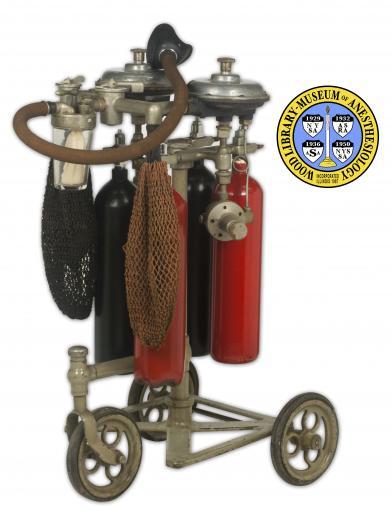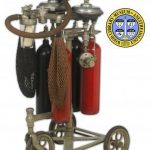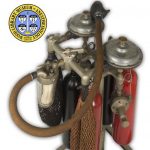Ohio Monovalve
The Ohio Monovalve was introduced in 1910 for the administration of nitrous oxide, oxygen and ether. It was developed by Graham W. Clarke, a founder of the Ohio Chemical Co., with the assistance of Agatha Hodgins (1877-1945), an accomplished and well-respected nurse anesthetist. The Ohio Monovalve was one of several anesthesia machines used in military field hospitals during WWI. A 1923 publication on US Army medical services during WWI stated that, "The Ohio Monovalve was found the most satisfactory because it was stable and did not get out of adjustment ... ." These are important qualities for military equipment that is frequently and roughly transported. The Ohio Chemical & Manufacturing Company, founded in 1910 in Cleveland Ohio, was a major manufacturer of anesthesia equipment.
Catalog Record: Ohio Monovalve
Access Key: aiqg
Accession No.: 2010-09-23-3
Title: Ohio [monovalve / designed by Graham W. Clarke and Agatha Hodgins].
Author: Clarke, Graham W.
Author: Hodgins, Agatha.
Corporate Author: Ohio Chemical & Mfg. Co.
Title variation: Alt Title
Title: Ohio Monovalve no. 3.
Publisher: Cleveland, Ohio: Ohio Chemical & Mfg Co., [1912-1930].
Physical Description: 1 anesthesia delivery apparatus : zinc alloy, steel, brass, other metals, paint ; 37 x 48 x 46 cm.
Subject: Anesthesia Machines.
Subject: Nitrous Oxide.
Subject: Oxygen.
Subject: Ether, Ethyl.
Note Type: General
Notes: Title based on manufacturer’s markings on the object and the manufacturer’s
publications.
Note Type: With
Notes: With the three-wheel stand the apparatus measures approx. 91 x 48 x 71 cm;
The stand is painted a dark khaki color and has many scratches and indents;
The rubber on the front and right wheel is loose, and all three of the wheels
are dry and cracked.
Note Type: Citation
Notes: Brown KL. Medicine in Cleveland and Cuyahoga County, 1810-1976. Cleveland:
Academy of Medicine of Cleveland, 1977:452.
Note Type: Citation
Notes: Thatcher V. History of Anesthesia With Emphasis on the Nurse Specialist.
Philadelphia, Lippincott, 1953:158.
Note Type: Citation
Notes: United States Army Medical Service. Medical Department of the United States
Army in the World War, Volume 5. Washington, D.C.: US Surgeon-General’s
Office, 1923-1929.
Note Type: Physical Description
Notes: An apparatus to administer anesthesia consisting of four pressure-reducing
valves (or automats) with turning control-knobs, four gas tank yokes, and two
regulating valves; For this description, the side with the two regulating
valves will be referred to as the front; The left side of the apparatus has
two gas tank yokes both marked with “N2O”; One protrudes toward the back and
the other toward the front; To the left and approx. 13 cm below the yokes is
a pressure-reducing valve (or automat), approx. 7 x 9 x 17 cm in size, that
receives nitrous oxide from the tanks; The lower automat is connected to a
second automat located approx. 18 cm above it; The second automat measures
approx. 13 x 18 cm dia.; The second automat connects to a dial-like
regulating valve approx. 8 cm in front of it; The regulating valve has a dial
that can be turned to point to markings on a small plate affixed to the
valve; The markings include, from left to right, tick-marks, “GALLONS N2O PER
HOUR”, and “OPEN”; There are short tick-marks between longer tick-marks that
are numbered 0, 15, 45, 60, 80, 100, 115, 130, 150, 170 and 180; The nitrous
oxide regulating valve connects to a second regulating valve approx. 10 cm to
the right; This second regulating valve is located in the front-center of the
apparatus, and also has a dial that can be turned; The plate with markings
for the dial is missing on the model described here; This plate on a similar
model has the following markings, from left to right: “OFF”, “PURE NITROUS
OXID”, 16 tick-marks, half tall and half short, marked with numbers in
“GALLONS PER HOUR”, 5, 15, 25, 40, 50, 55, 60, 65, “PURE OXYGEN”, “OFF”; The
right side of the apparatus has two gas tank yokes both marked with “O”; One
protrudes toward the back and the other toward the front; To the left and
approx. 13 cm below the yokes is an automat, approx. 7 x 9 x 17 cm in size,
that receives oxygen from the tanks; The lower automat is connected to a
second automat located approx. 18 cm above it; The second automat measures
approx. 13 x 18 cm dia.; The second automat connects to the dial-regulating
valve located in the front-center of the apparatus.
Note Type: Reproduction
Notes: Photographed by Mr. William Lyle, Sept. 23, 2010; In order to present an
image of the apparatus in the best state possible, this example was
photographed with the following alterations: The dial regulating-valve
assembly was replaced with one in better condition from a similar model
(accession no. 2010-09-23-04). Also added were, a monovalve vaporizer
(accession no. 106), net-bags from a New Clark Machine (accession no. 447),
and gas cylinders and rubber parts from the Parts Collection.
Note Type: Historical
Notes: The Ohio Monovalve was developed by Graham W. Clarke, a founder of the Ohio
Chemical Company, with the assistance of Agatha Hodgins, a well respected
nurse anesthetist who worked closely with Dr. George Crile (Thatcher, 1953).
The Ohio monovalve was used during WW I in some military field hospitals. A
1923 publication on US Army medical services during WW I stated that, “The
Ohio Monovalve was found the most satisfactory because it was stable and did
not get out of adjustment …” (United States Army Medical Service, 1923).
Note Type: Historical
Notes: The Ohio Chemical & Manufacturing Co. was founded in 1910 in Cleveland Ohio
and became a major US developer and manufacturer of anesthesia equipment
(Brown, 1977).



